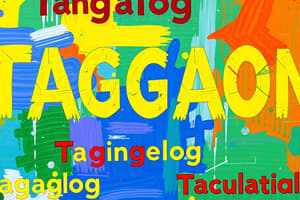Podcast
Questions and Answers
Что такое спряжение глаголов?
Что такое спряжение глаголов?
- Изменение глагола для отображения его времени, аспекта, наклонения, голоса и лица. (correct)
- Форма глагола, используемая во всех языках без исключения.
- Процесс выбора правильного времени для использования в предложении.
- Замена одного глагола на другой в предложении.
Какой из следующих аспектов не относится к спряжению глагола?
Какой из следующих аспектов не относится к спряжению глагола?
- Наклонение
- Местоимение (correct)
- Лицо
- Количество
Какой тип наклонения выражает желание или возможность?
Какой тип наклонения выражает желание или возможность?
- Императив
- Условное наклонение
- Индикатив
- Субъюнктив (correct)
Какое время обозначает завершенное действие?
Какое время обозначает завершенное действие?
Какую роль выполняет глагол в активном залоге?
Какую роль выполняет глагол в активном залоге?
Что включает в себя неправильные глаголы?
Что включает в себя неправильные глаголы?
Какое из следуюших утверждений является ложным?
Какое из следуюших утверждений является ложным?
Какое утверждение о таблицах спряжения является верным?
Какое утверждение о таблицах спряжения является верным?
Какую из следующих характеристик не влияет на спряжение глагола?
Какую из следующих характеристик не влияет на спряжение глагола?
Каковы основные типы спряжений?
Каковы основные типы спряжений?
Какое время глагола указывает на действие, происходящее в данный момент?
Какое время глагола указывает на действие, происходящее в данный момент?
Какое из следующих определений относится к неправильным спряжениям?
Какое из следующих определений относится к неправильным спряжениям?
Какое из перечисленных свойств может изменить форму глагола?
Какое из перечисленных свойств может изменить форму глагола?
Какой эффект имеет изучение спряжения на коммуникацию?
Какой эффект имеет изучение спряжения на коммуникацию?
Какой аспект не является важным при изменении формы глагола?
Какой аспект не является важным при изменении формы глагола?
Что такое простое спряжение?
Что такое простое спряжение?
Flashcards
Спряжение глаголов
Спряжение глаголов
Процесс изменения глагола для указания времени, вида, наклонения, залога и лица.
Лицо глагола
Лицо глагола
Указывает, кто совершает действие (1-е лицо – я, мы; 2-е лицо – ты, вы; 3-е лицо – он, она, оно, они).
Число глагола
Число глагола
Указывает, является ли подлежащее единственным или множественным.
Время глагола
Время глагола
Signup and view all the flashcards
Наклонение глагола
Наклонение глагола
Signup and view all the flashcards
Залог глагола
Залог глагола
Signup and view all the flashcards
Неправильные глаголы
Неправильные глаголы
Signup and view all the flashcards
Важность спряжения
Важность спряжения
Signup and view all the flashcards
Паттерны спряжения
Паттерны спряжения
Signup and view all the flashcards
Спряжение глаголов
Спряжение глаголов
Signup and view all the flashcards
Лицо глагола
Лицо глагола
Signup and view all the flashcards
Число глагола
Число глагола
Signup and view all the flashcards
Время глагола
Время глагола
Signup and view all the flashcards
Регулярные глаголы
Регулярные глаголы
Signup and view all the flashcards
Неправильные глаголы
Неправильные глаголы
Signup and view all the flashcards
Виды спряжений
Виды спряжений
Signup and view all the flashcards
Значение спряжения
Значение спряжения
Signup and view all the flashcards
Активный залог
Активный залог
Signup and view all the flashcards
Пассивный залог
Пассивный залог
Signup and view all the flashcards
Наклонение глагола
Наклонение глагола
Signup and view all the flashcards
Study Notes
Conjugation of Verbs
- Conjugation is the process of changing a verb to show its tense, aspect, mood, voice, and person.
- Verbs are inflected to reflect the grammatical role of the subject in the sentence. This includes the subject's person (first, second, or third), number (singular or plural), and the tense of the action.
Conjugation Patterns
- Different languages have different patterns of verb conjugation.
- Some languages have a large number of verb conjugations for different aspects and moods.
- The structure of conjugations can be highly regular, with predictable patterns, or irregular, with exceptions and unique forms.
Key Aspects of Verb Conjugation:
- Person: Specifies who performs the action (first person – I, we; second person – you, you all; third person – he, she, it, they).
- Number: Indicates whether the subject is singular or plural.
- Tense: Indicates the time of the action (present, past, future). Includes aspects like perfect (completed action) and imperfect (ongoing action).
- Mood: Describes the manner in which the action is expressed (indicative – stating a fact; imperative – giving a command; subjunctive – expressing a desire or possibility).
- Voice: Shows the relationship between the subject and the action (active – subject performs the action; passive – subject receives the action).
Examples (Illustrative - Needs language context)
- Consider the verb "to eat" in English. Different forms ("eat," "eats," "ate," "eating," "eaten") signify various combinations of tense and person.
- Similar patterns exist in other languages (e.g., French, Spanish, Russian) but with differing structures.
Irregular Verbs
- Some verbs exhibit irregularities in their conjugation.
- These often form exceptions to the standard patterns.
- Learners must memorize the irregular forms.
Importance of Conjugation
- Proper conjugation is essential for clear communication.
- Incorrect conjugation can lead to misunderstandings or grammatical errors.
- Mastering conjugation is crucial for achieving fluency in a language.
Conjugation and Language Learning
- Conjugation tables are a common learning tool.
- Understanding conjugation patterns allows for more accurate and natural language use.
- Focusing on the reasoning behind conjugations rather than rote memorization can aid learning.
Studying That Suits You
Use AI to generate personalized quizzes and flashcards to suit your learning preferences.



